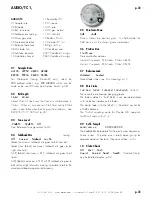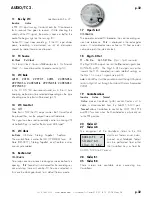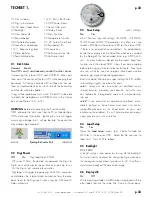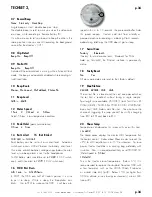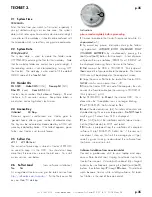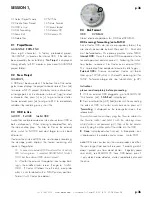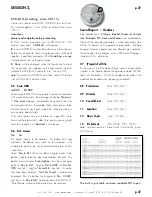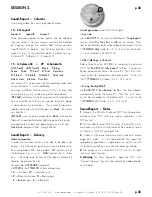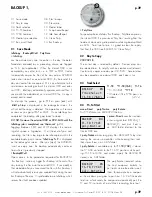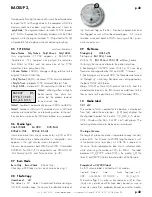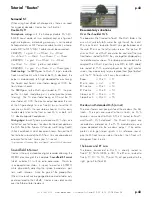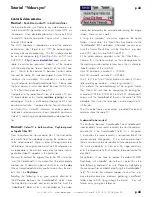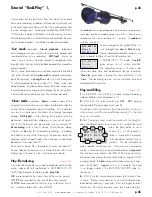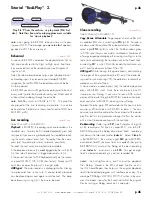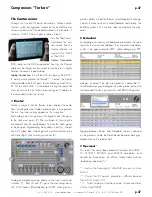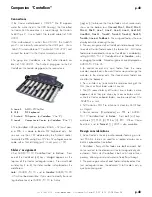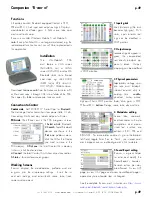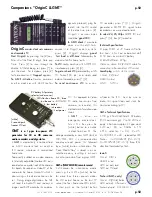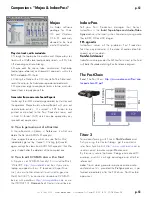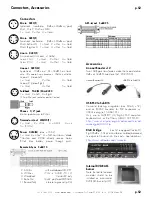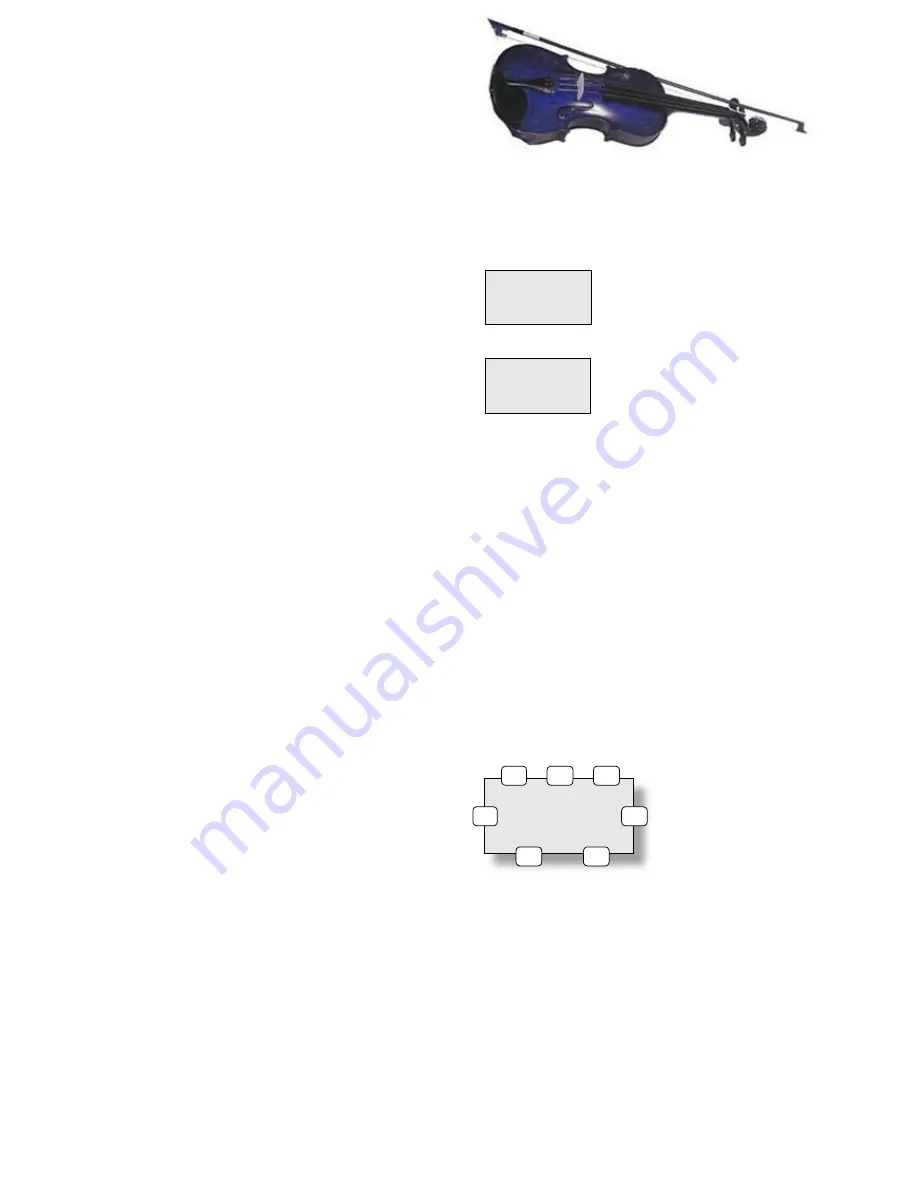
+33 4 7642 9550
www.aaton.com
User manual for Cantar-X1 & X2 v2.15 2008 March 28
p.45
p.45
Cantar plays up to eight tracks from the internal or external
drive while recording a selection of these tracks (internally sent
to the eight Digi-inputs) along with the 'live' audio coming from
the nine analog inputs. To activate the Rec&Play BLUE-FUNC-
TIONS, press the blue [shift] button while transitioning to a new
MainSelector position, and hold it for one second after the posi-
tion has been reached. Two different modes are available.
'Live' mode
examples:
Classic playback -
telephone
calls, background music and wild sounds are played and
recorded during a live recording.
ADR type1
- known as
‘hear it/say it’ session: the actor records his replacement dia-
log
right after
listening to the playback opened then closed by
preset cue-points.
The TC, scene, take, comments and track-names are those of the
'live' take. At each call of a
play-card
(an operator preset play-
back file segment), a
Linking-Trio
(note1) links the filetag and
TC of the playback to the new take's TC. Thanks to the zero
delay between the play command and the audio output, plus
the sub-frame post-syncing precision brought by the Linking-Trios,
Cantar makes external players and ‘Music-Slates’ obsolete.
'Clone' mode
examples:
Remix -
make a copy of the
original iso tracks and a new mixdown performed under the
control of the on-board mixer or CantaRem. This mode lets
you insert a simultaneous translation of a foreign language
dialog.
ADR type2 -
while listening to the guide track the
performers re-record their dialog on a new set of tracks.
The TC of the master can be used to sync a chasing VTR.
Re-recording
- with its short 0.4msec ‘Mic to Phones’ delay,
Cantar is a blessing for incremental recording, i.e. adding
one track at a time while listening to the previous track(s) to
produce 'packs' of eight tracks which are easy to stack later
because of their identical TCs.
Each time a 'clone' file is recorded, it carries the same TC,
Scene, Take and Comments as its master file
but with a new
filetag;
you will never run the risk of erasing a master.
Play-file indexing
Cantar-X1 & X2
First select the audio files you need to playback and put them
under indexes
A
to
L
, performed in BLUE-BRWS.01/20
(p.25) they become 'rec&play ready'
play-files
.
A B
are reserved for the
current day
of the
current project
C D E F
are reserved for
any day
of the
current project
G H I J K L
are reserved for
archives
, e.g. wild tracks, music,
etc., stored on external or internal HDDs.
The
archive
files must be grouped on the same drive, same project,
same day, and their metadata stored in an iXML v1.50a chunk in
compliance with Cantar software v2.11 or later. To
update
old
style files, see p.25.
To ease navigation during Rec&Play, it is
wise to toggle from
view
to
hide
the play-
files not needed immediately; to do so, use
[esc] instead of [ok] to exit from the file selection row.
In BLUE-BRWS.21 'TC mode', '
Live (all)
'
gives access to
all visible play-files.
T
he recording session will work under
the current date, time and metadata of the live recording;
'
Clone (x)
'
gives access to
play-file x
only and forces it into
'
view
'. The recording session will use the date, time and
metadata of this play-file.
Play-card filling
Cantar-X1 & X2
1-
In BLUE-PLAY, with [shift] [>], choose a play-file among
indexes
A to L,
index displayed in (1).
2-
With [>] or [<], select a card, e.g.
A01
...
A51
, among
the available fifty-one empty cards per file.
The factory A00 card contains the entire play-file, it does not
store a cue-in, and the non modifiable cue-out (7) is the take
end, i.e. its duration.
3-
To fill an empty card, scrub the audio with the [jog] (4),
press the [black] button to set a cue-in (3), scrub further and
press the [red] button to set a
cue-out (7); a half second si-
lence is inserted at the cue-out
to let you detect and fine tune its
position. The last entered cue
points replace the former ones.
Once a cue-in is entered (a
cue-out is not necessary), an empty card becomes a
play-card
.
The cue points are stored in the iXML of the file and will only
be removed by erasing the play-card; to do so, [jog] to 00:00
and press [red]. To
hide
a play-card without erasing its cues,
press [shift] [red]. Tagged with a '
*
' character the card
is no longer visible in the BLUE-TEST/BLUE-REC play list,
shortening it .
4-
With [>] select a play-card and press [ok] to play it from
its cue-in. If there is no cue-out or if you want to stop the play-
back before reaching it, press [ok]. Press [ok] again to restart
from cue-in. Press [esc] to pause, press [esc] to resume play.
Tutorial "Rec&Play" 1,
BLUE-BRWS 21
TC mode <
Clone (x)
BLUE-BRWS 08
Index D <
SE1104 hide
A01* > 01:45
02:15 02:17
CC2165 ––:––
1
2
3
4
5
6
7

